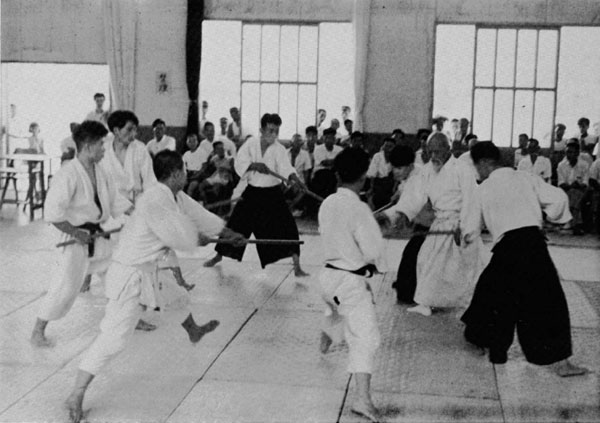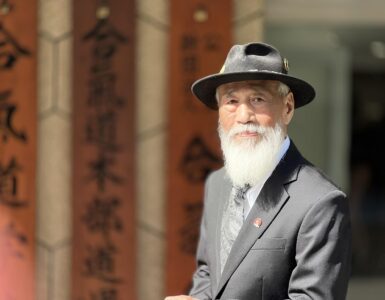“No aikido technique could have prepared Guy for this situation and it is unlikely that any aikido school would have taught a specific defense against a stab in the back delivered from the front.”
 Guy was stabbed in the back three times.
Guy was stabbed in the back three times.
A student of our dojo with the sometimes hazardous occupation of nightclub proprietor, he was trying to restrain a scrawny, green-haired youth who had assaulted one of the bar staff. While Guy was holding his jacket from the front, the green-haired one suddenly went berserk, reached around behind Guy and began frantically stabbing him in the back with a flick-knife.
It was not a scenario covered by the standard aikido techniques.
As luck would have it, and perhaps because this was not the most effective way to stab someone, the knife failed to penetrate any vital organs, although an artery was punctured and Guy could have bled to death if the ambulance had not arrived when it did.
When his wounds healed he was back on the mat training with his usual enthusiasm.
No aikido technique could have prepared Guy for this situation and it is unlikely that any aikido school would have taught a specific defense against a stab in the back delivered from the front.
It is not difficult, after the event, to think of defensive strategies that could have been employed and combinations of techniques that could have coped with the situation. Safe-distance (maai), awareness and the ability to adapt to the unexpected would all have been of vital importance. But these mental aspects also are easier said than done.
Those who insist on seeing aikido in the single dimension of self-defense could well seize on this case to condemn our dojo for failing to teach practical moves. They might even say that this incident only goes to show how useless aikido would be in a real situation.
I mention the incident, not to dwell on the sensational, but to support my belief that there is no way technique alone could prepare you to deal with such a scenario. The reality people talk about is usually the kind they imagine they themselves could control, if only they learned the appropriate technique. It is more fantasy than reality.
Even without falling back on philosophy or religion, the psychological aspect of training quickly assumes paramount importance in a situation of real danger like the one described. And even if you have this aspect well in hand, bad luck—being in the wrong place at the wrong time—could still work against you.
Thus, to be truly practical, we cannot escape wider considerations, such as how we live our lives, whether we should put ourselves in positions of potential danger and how we might work to reduce the overall level of violence in our society. These questions have always been part of aikido but are frequently dismissed as unimportant by the one-dimensional advocates of realism in training. I refer to those who would like to extract only the most effective techniques from the aikido repertoire and discard all the philosophical trimmings.
There is a pertinent Zen anecdote about a sword master’s disciple who was assigned mundane tasks, like cleaning the dojo garden, for a prolonged period after his acceptance into the dojo, without being taught any of the sword techniques he had come to learn. He complained and asked to be given some experience of real swordsmanship—only to regret this immediately when the master then began to hound him mercilessly with a wooden sword. Wherever he went, the master would suddenly leap out at him from nowhere and attack him—certainly giving him a taste of the real thing. His life became hell.
I mention the incident, not to dwell on the sensational, but to support my belief that there is no way technique alone could prepare you to deal with such a scenario. The reality people talk about is usually the kind they imagine they themselves could control, if only they learned the appropriate technique. It is more fantasy than reality.
Totally stressed out, the disciple eventually begged to be allowed to resume his dojo chores in peace. His work then took on a new feeling of awareness and concentration.
After a while he had the idea of getting his own back, and seeing the master in a vulnerable position, with both hands occupied as he stirred a pot of soup in the kitchen, he attacked him with his wooden sword. Without hesitation, the master blocked the attack with the lid of the pot and sloshed the disciple with the hot soup ladle
If I have the story right, the moral appears to be that real mastery goes beyond technique and that training has to start and finish in the right state of mind. The dojo chores are part of the process of bringing out this mental state, without which technique alone would be of no use. An intense dose of reality, at the right moment, could bring the student to realize this fact.
I wonder how many of the critics of aikido would be willing to be on the receiving end of real, serious attacks? I imagine they, like the disciple in the story, would very quickly vote for a return to their normal life.
In this day and age, of course, there may not be many volunteers for this kind of training and there are few masters (psychologist-senseis) capable of using such an approach successfully. But it would still be both arrogant and foolish—and unrealistic—to focus solely on technique. Holistic training, involving all aspects of your life, would seem to be the only worthwhile and sensible course, combined with a determination to stay out of trouble.
Life-and-death situations cannot really be rehearsed, no matter how “realistically” one trains, and real, uncontrolled violence is not something any sane person would go out looking for. If you want to play at being strong or skillful in a contest (with strict limitations on the degree of reality) there are any number of competitive sports where you can do this to your heart’s content. They are not budo, not aikido and not realistic.
You could also buy a flick-knife.
Just as people underestimate the difficulty in dealing with a life-and-death encounter, I think they underestimate and undervalue the depth and breadth of aikido. They would like something that could be mastered in a few years, would make them strong enough to challenge all comers with impunity and would perhaps convey a measure of “mysterious power” at the same time.
In my experience—admittedly only 35 years—this is totally unrealistic. Aikido has shown me how vulnerable I am, rather than filled me with power. To grasp its message of peace may not be easy, since this requires inner change, but it seems to me the only worthwhile approach to have. The incredible variety and subtlety of aikido make me feel a perpetual beginner.
Life-and-death situations cannot really be rehearsed, no matter how “realistically” one trains, and real, uncontrolled violence is not something any sane person would go out looking for. If you want to play at being strong or skillful in a contest (with strict limitations on the degree of reality) there are any number of competitive sports where you can do this to your heart’s content. They are not budo, not aikido and not realistic.
Aikido can be as deep as you may care to discover for yourself, and a real source of energy and insight; a path to guide every aspect of your life, but if you want to focus exclusively on its “practical” aspects you may well invite into your life something you would ultimately live to regret. And you would be missing so much.













Actually, this is an excellent argument for teaching realistic and effective grabs. The scrawny guy had already demonstrated violence so there isn’t a big argument about reasonable force. If a grab is used that reverses the elbow, like morote dori, for instance that controls one hand, puts the other out of range and gives the grabber purchase to move the scrawny guy out the door, to the floor or whatever is convenient. The most common “street” response is to spin. That allows transition to a hammer lock on the original grabbed arm and a “shime” with the now extra hand. Of course there are aikido responses to any of these (assuming that you start with a realistic and effective grab in the dojo)…
Nicely reasoned article, David! We do live in a mindset that believes learning “realistic and effective” techniques is aikido, just as a “7-Step Formula” is the respectful relationship that leads to sales. The deep learning of flowing with nature, people, and situations comes with attention, humility, listening, relaxing, inviting, and all those attitudes that requires reaching beyond the instant gratification and promise of “techniques.”
Through a focus on techniques we promote violence. The attitude of “applying a technique” does not consider connecting with someone spontaneously. It does not allow a range of responses appropriate to the situation. For example, the teacher’s response of splashing hot soup in the student’s face was playful yet telling.
I believe the way to reducing violence in your world, is to reduce your violent reactions to people and situations. Then things change, and your world presents differently. Aikido is without doubt one of the most sophisticated arts (not self defence) that offers the opportunity to meet another with complete non-violence.